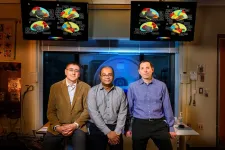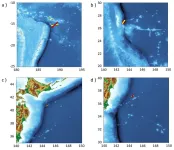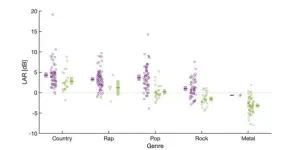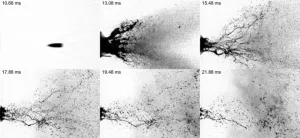(Press-News.org) Investigators at Cedars-Sinai have created computer-generated models to bridge the gap between “test tube” data about neurons and the function of those cells in the living brain. Their study, published in the peer-reviewed journal Nature Communications, could help in the development of treatments for neurological diseases and disorders that target specific neuron types based on their roles.
“This work allows us to start looking at the brain like the complex machine that it is, rather than as one homogenous piece of tissue,” said Costas Anastassiou, PhD, a research scientist in the departments of Neurology, Neurosurgery and Biomedical Sciences at Cedars-Sinai and senior author of the study. “Once we are able to distinguish between the different cell types, instead of saying that the entire brain has a disease, we can ask which neuron types are affected by the disease and tailor treatments to those neurons.”
Neurons are the main functional units of the brain. The signals passing through these cells—in the form of electrical waves—give rise to all thought, sensation, movement, memory and emotion.
The study used data from laboratory mice to establish a new method for examining relationships between neuron type and function, and focused on the mouse primary visual cortex, which receives and processes visual information. It is one of the best studied parts of the brain—both in vitro, where tissue is studied in a dish or test tube outside the living organism, and in vivo, where it is studied in the living animal.
The investigators’ goal was to link the two worlds.
“Based on in vitro studies of genetic makeup and physical structure, we know something about what various classes of neurons look like, but not their function in the living brain,” Anastassiou said. “When we record the activity of brain cells in vivo, we can see what neurons are responding to and what their function is, but not which classes of neurons they are.”
To link form to function, investigators first used in vitro information to create computational models of various types of neurons and to simulate their signaling patterns.
They next took advantage of the newest technology in single-neuron recording to observe activity in the brains of laboratory mice while the mice were exposed to different sorts of visual stimuli. Based on the shapes of the signals or “spikes” of neurons in response to visual input, investigators separated the cells they recorded into six groups.
“Once we had our models and our in vivo data, the fundamental question was which computational models produced the most similar signaling shape and waveform to each of the six in vivo clusters we identified, and vice versa,” Anastassiou said. “Not all of the in vivo clusters and models matched perfectly, but some did.”
More data, and possibly experiments involving more-sophisticated visual stimuli, might be required to match all the computational models and cell clusters, and Anastassiou said that future studies will be dedicated to perfecting the method established in the current paper.
“There’s a wealth of information about the identity of cell types in the human brain, but not about the role of those cell types in cognitive functioning or how they are affected by disease,” Anastassiou said. “Now there is a window through which we can look at these things and ask these questions. It’s clear that we have a long way to go, but we’re excited about the next steps in this journey.”
The ultimate goal is to pave the way for discoveries that change patients’ lives.
“Our research scientists are continually striving to expand our knowledge of the workings of the human brain at the most detailed level,” said Keith L. Black, MD, chair of the Department of Neurosurgery and the Ruth and Lawrence Harvey Chair in Neuroscience at Cedars-Sinai. “Pinning down the specific type and function of each neuron may one day lead to the discovery of lifesaving treatments for brain diseases and neurological disorders.”
Funding: This research was supported by National Institutes of Health grant number RO1 NS120300-01; National Natural Science Foundation of China grant number 12101570; and Scientific Project of Zhejiang Lab grants 2021KE0PI03, 2022KI0AC01, 2022KI0AC02 and 2022ND0AN01.
END
Matching form and function of brain cell types
Cedars-Sinai investigators create computational models to help determine the identities and roles of individual neurons in the brain’s complex machine
2023-04-25
ELSE PRESS RELEASES FROM THIS DATE:
Small steps can yield big energy savings and cut emissions from MRIs
2023-04-25
Medical centers around the world could significantly reduce their carbon footprint and expenses by turning off MRIs and putting them in the lowest power mode instead of idling them when not in use, a new study in Radiology found.
Health care is responsible for up to 4.4% of global carbon emissions, and imaging contributes an outsized share due to its energy-intensive devices, especially MRI. A 2020 study found that three CTs and four MRIs used the same amount of energy per year as a town of 852 people, for example.
Though turning a machine off is better than idling, a substantial amount of MRI energy consumption occurs in “off” ...
Study links nutrients, brain structure, cognition in healthy aging
2023-04-25
CHAMPAIGN, Ill. — In a new study, scientists explored the links between three measures known to independently predict healthy aging: nutrient intake, brain structure and cognitive function. Their analysis adds to the evidence that these factors jointly contribute to brain health in older adults.
Reported in the Journal of Nutrition, the study found that blood markers of two saturated fatty acids, along with certain omega-6, -7 and -9 fatty acids, correlated with better scores on tests of memory and with larger brain structures in the frontal, ...
UNC Charlotte faculty member receives NASA Exobiology grant
2023-04-25
For the first time in the University of North Carolina at Charlotte’s nearly 80-year history, a faculty member has won a NASA Exobiology grant. Assistant Professor of Bioinformatics and Genomics Richard Allen White III will use the ultra-competitive grant in his research on microbialites, a kind of “living rock” that could hold the key to how life formed on Earth.
Microbialites form when microbial mats, living colonies of mostly bacteria, transform into stronger hard structures. White explores how viruses may have helped to kickstart the transformation (i.e., lithification) of modern microbialites, which ...
Study: Treatment for opioid addiction lags despite policies designed to increase it
2023-04-25
Treating opioid addiction should be much easier now than it was a few years ago, thanks to pandemic-era rule changes that aim to improve access to buprenorphine, a medicine proven to help in recovery.
But a new study shows the rate of people starting on buprenorphine remained flat from 2019 through 2022, while the percentage of patients who stayed on buprenorphine for at least six months hovered at just over 20% from 2016 through 2022.
Until more health care providers start offering buprenorphine treatment -- and to take advantage of opportunities like emergency visits and hospitalizations ...
Creating a tsunami early warning system using artificial intelligence
2023-04-25
WASHINGTON, April 25, 2023 – Tsunamis are incredibly destructive waves that can destroy coastal infrastructure and cause loss of life. Early warnings for such natural disasters are difficult because the risk of a tsunami is highly dependent on the features of the underwater earthquake that triggers it.
In Physics of Fluids, by AIP Publishing, researchers from the University of California, Los Angeles and Cardiff University in the U.K. developed an early warning system that combines state-of-the-art acoustic technology with artificial intelligence to immediately classify earthquakes and determine potential tsunami ...
Lead vocal tracks in popular music go quiet
2023-04-25
WASHINGTON, April 25, 2023 – A general rule of music production involves mixing various soundtracks so the lead singer’s voice is in the foreground. But it is unclear how such track mixing – and closely related lyric intelligibility – has changed over the years.
Scientists from the University of Oldenburg in Germany carried out an analysis of hundreds of popular song recordings from 1946 to 2020 to determine the lead vocal to accompaniment ratio, or LAR. Their results appear in JASA Express Letters, published on behalf of the ...
Treating polluted water with nanofiber membranes
2023-04-25
WASHINGTON, April 25, 2023 – When oil contaminates water, it creates a film that reduces oxygen levels and introduces toxic substances. This can lead to the death of aquatic plants and animals, contaminate soil, and ultimately threaten human health.
Separating oil from polluted water is therefore of great importance. Current methods can be expensive and challenging, and some may introduce further pollutants into the system. For example, membrane materials can act as a barrier to intercept ...
Trends in buprenorphine initiation and retention
2023-04-25
About The Study: During January 2016 through October 2022, the monthly buprenorphine initiation rate in the U.S. increased, then flattened. This flattening occurred prior to the COVID-19 pandemic, suggesting that factors other than the pandemic were involved.
Authors: Kao-Ping Chua, M.D., Ph.D., of the University of Michigan Medical School in Ann Arbor, is the corresponding author.
To access the embargoed study: Visit our For The Media website at this link https://media.jamanetwork.com/
(doi:10.1001/jama.2023.1207)
Editor’s Note: Please see the article for additional information, including other authors, author contributions ...
Improving bloodstain pattern analysis with fluid dynamics
2023-04-25
WASHINGTON, April 25, 2023 – Often left on the surfaces of a crime scene or on the clothes of an accused criminal, blood back spatter can be used as evidence for forensic scientists to reconstruct what occurred. However, the fluid dynamics at play are complicated, and neglecting the interaction between the blood and the muzzle gases from the firearm could skew the results.
In Physics of Fluids, by AIP Publishing, researchers from the University of Illinois Chicago and Iowa State University modeled the behavior of blood drops during secondary atomization to examine how the phenomenon affects a crime scene.
“Primary atomization of blood is caused by ...
Self-awareness of memory function and clinical progression in cognitively normal older adults
2023-04-25
About The Study: In this study of 436 cognitively normal older adults, unawareness, rather than heightened awareness, of memory decline was strongly associated with future clinical progression, providing further support that discordant self- and informant-reported cognitive decline may provide important information to practitioners.
Authors: Patrizia Vannini, Ph.D., of Brigham and Women’s Hospital in Boston, is the corresponding author.
To access the embargoed study: Visit our For The Media website at this link https://media.jamanetwork.com/
(doi: 10.1001/jamanetworkopen.2023.9964)
Editor’s Note: Please see the article for additional information, including ...
LAST 30 PRESS RELEASES:
American Physical Society launches APS Open Science to expand global participation in trusted physics research
Family dogs boost adolescent mental health through the microbiome
Prehab can improve recovery after surgery, but barriers remain
Ten-thousand-year-old genomes from southern Africa change picture of human evolution
NeuMap: a pioneering map of neutrophils that redefines their role in health, infection, and inflammation
KATRIN tightens the net around the elusive sterile neutrino
Antipsychotic medication use by older adults
Statewide analysis quantifies life-saving potential of stop the bleed
Complex life developed earlier than previously thought, new study reveals
Semaglutide and early-stage metabolic abnormalities in individuals with schizophrenia spectrum disorders
Robert Wood Johnson University Hospital and Rutgers Robert Wood Johnson Medical School receive National Rare Disease Center of Excellence recognition
The Mohn Prize for 2026 awarded to Canadian John Smol
Americans more likely to accept guidance from AMA than CDC on vaccine safety
How two Russian scientists changed the way we understand aging and cancer
Noninvasive imaging could replace finger pricks for people with diabetes
Genome Research publishes a special issue on advances in computational biology and their applications in genomics
Announcing the 2025 Glenn Foundation for Medical Research Discovery Awards: Christina Camell, PhD (University of Minnesota) and Elaine Fuchs, PhD (The Rockefeller University)
Groundbreaking simulations show how black holes glow bright
When schizophrenia meets a personality disorder: why more research is urgently needed
SwRI may have solved a mystery surrounding Uranus’ radiation belts
Anna Gloyn wins 2026 Transatlantic Alliance Award in Endocrinology
FAU study finds connection between poor mental health and dark web use
A new study finds high-narcissism CEOs pursue more acquisitions in response to strong firm performance
During times of market volatility, investors should track insider trades
Fish freshness easily monitored with a new sensor
Antibiotics could trigger immune response through gut microbiome metabolites
New Family Heart Foundation study finds only 13% of adults with cardiovascular disease achieve comprehensive LDL-C management
UT San Antonio physicists' groundbreaking discoveries open new paths to combating diseases
Operando X-ray tomography reveals silicon–electrolyte interface dynamics in all-solid-state batteries
Building better, building beautiful
[Press-News.org] Matching form and function of brain cell typesCedars-Sinai investigators create computational models to help determine the identities and roles of individual neurons in the brain’s complex machine





